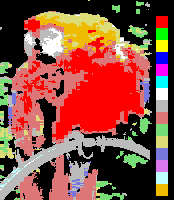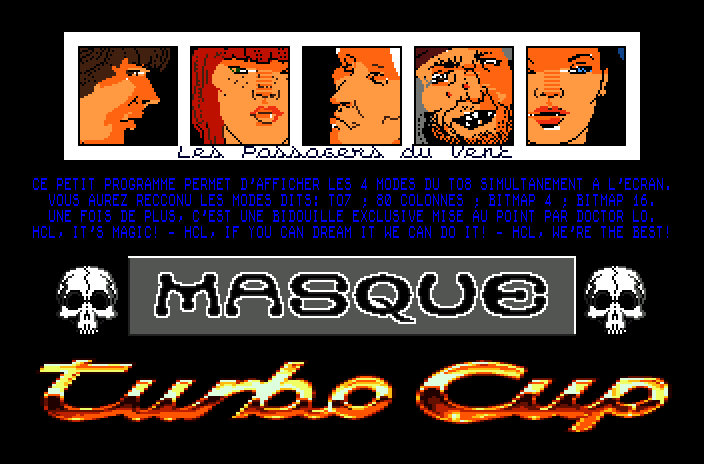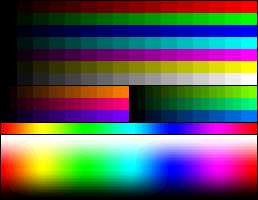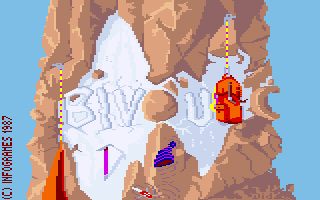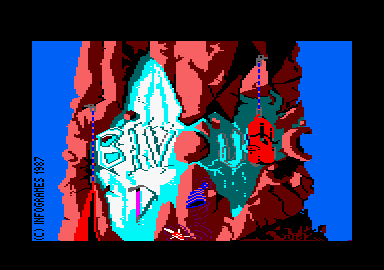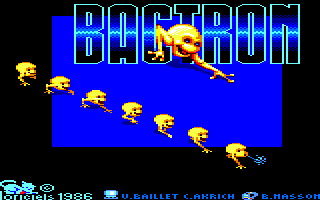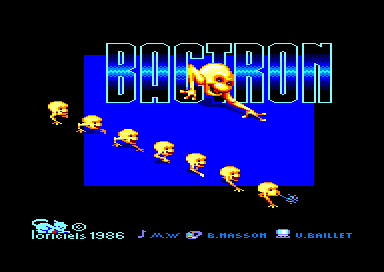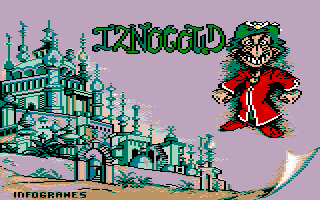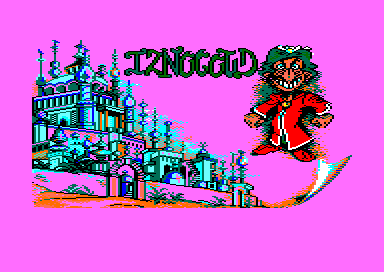Thomson is a French High tech corporation who produce Weapons or HI-FI Electronic devices.
It used to produce 8-bit home computers in the 80's though sub-companies : SIMMIV (Société Internationale de Micro-Informatique et de Vidéo) also known as Thomson Micro. (1983-1989)
Despite those machines were litteraly whipped out by Amstrad in the French market, they remains a well known fail in France, and is still quite beloved in this country by those who knew them at school.
As we say : Proudly Merde in France.
History : a French phenomenon
Despite this they were quite common because in the 80's, the french governement started a program "Plan informatique pour tous" (computering for all plan) which consisted of equipping schools with computers networks.
As a result, a lot of Thomson computers were almost only sold to schools, appart from the few infortunates who got one instead of an Amstrad CPC.
Range and products
The Thomson 8bit computers are 6809E CPU based (1mhz)
They were released in a lot of models variations (mostly concerning the keyboard or colour of the casing) from 1983 to 1989.
While MO and TO models are uncompatible in software, most of the peripherals and Hardware were compatible.
2nd generation was almost fully retro-compatible with 1st generation but specific 2nd generation softwares couldn't run on 1st generation computers.
Those compatibilities issues were fatal to the range alongside the success of the Amstrad CPC in France.
First generation :
- MO5
- TO7 and TO7/70
Second generation :
- MO6 : 128K Ram and built in Tape driver.
- TO8 and TO8D : 256K Ram and Built-in 3"1/2 Disk drive for the TO8D version (D=Disk)
- TO9 and TO9+ : professionnal casing with separate Keyboard and Central unit. The "+" version has an in-built Modem.
PC compatible :
- TO16
Funny Stuff :
- NanoReseau (Nano-Network) was a Network solution very "popular" as it was largely used in France's Schools. Actually some sort of Ethernet.
Palette and Video Modes
MO5 and TO7
And TO7/70.
The 1st generation of 8 bit thomson computers have a custom 4-bit RGBI palette of 16 colours.
Quite comparable with the ZX Spectrum, MSX1 or CGA palettes, it is indeed done with a range of medium and bright tones instead of dark and medium (spectrum). Also it is to notice that instead of having 2 Black slots (as on Spectrum), one was replaced by an Orange.
Resolution : 320x200x16 colours in 8x1 attributes (2 colours per attributes)
The Attribute system was comparable to MSX1 with attributes of 8x1 and 16 colours diplayable on screen (2 per attributes), but with a 320x200 resolution instead of a 256x200 resolution..
Graphically the MO5/TO7 are superior to ZX Spectrum in almost every way.
MO6 and TO8
Also TO9/TO9+, MO5E.
The 2nd generation of 8 bit Thomson computers mostly got the addition of the 3 bitmap video modes (no attributes) of the Amstrad CPC/PLUS, alongside the "heritage" (legacy) 320x200x16 attribute based mode. A few other exotic and obscure video modes were added too.
But the palette have been upgraded into a 4096 colours 12bit palette, the same as on the unreleased at the time Amstrad PLUS range (and of course the Commodore Amiga... and many other computers and consoles).
- Those video modes are, according to the TO8 documentation :
(pixels x pixels x colours)
* a) MO 40-column mode : 320x200x2 (with 8x1pixels attributes , 16 colours on screen)
* b) 80 column mode : 640x200x2
* c) BIT MODE MAP 4 : 320x200x4
* d) BIT MODE MAP 16 : 160x200x16
- further Extra Video modes : Those Thomson computers also had a few extra video modes that enabled transparency-masked plans (but with less colours than the usual CPC-like bitmap modes) and which could be used for video incrustation. Another mode enabled to manage 2 separate pages (screen) at the same time.
* e) Mode page (page1/page2) : this enable to provides 2 separate screen pages in 320x200x2.
* f) Overprinting Mode : 320x200 sized screen,
- 2nd plan is 1 colour+transparency on the 1st plan
- 1st plan is 2 colours (possible 3 colours on screen+border)
* g) Triple-Overprinting Mode : Four 1bit per pixel plans on the same screen in 160x200.
- 4th pan is 1 colour+transparency into 3rd plan
- 3rd plan is 1 colour+transparency into 2nd plan
- 2nd plan is 1 colour+transparency into 1st plan
- 1st plan is 2 colours.
This make-up for a total of 5 colours on screen (+ border).
Those Bitmap video modes are coded (hardware generated) slightly differently than on CPC so you can't simply port the Graphic Datas from CPC/PLUS to Thomson MO6/TO8 without some proper recoding.
The Thomson always processes 16bits of graphical Datas in the same clocktime so the more resolution the less colours.
Minus the lack of Hardware sprites and raster interrupt facilities (still doable on Thomson machines), the MO6 and TO8 are actually superior (in graphics) to the Amstrad PLUS Range due to the attribute based mode in addition to the 3 "CPC-like" modes, and largely superior to the Amstrad CPC due to the awesome Palette.
Impact on French market
As a french computer, french games producers ported a good amount of their games on those computers.
Thomson computers were known to have been used in some "common developpments" and ports for Amstrad CPC games.
As later MO6/TO8 models did include Video mode similar to Amstrad CPC's ones, in addition to a 16 colours character attributed mode (like on MSX1 or Spectrum...more like the MSX1 though...) and a 4096 colour palette, the portage was easier.
Also those later models included more RAM than Amstrad's 8 bit computers, hence being sometimes more faithfull to Atari ST version.
But those computers were lacking a decent sound chip as it was shipped with only a "beeper". Thomson said more decent sound system would be included into cartridges, but they would never be available.
Even the AY seems like a Sid in comparison.
Almost only market was France (perhaps a few sold in Italia), where Amstrad litteraly raped Thomson's market shares in their homeland.
The fact was that the Amstrad CPC was more well rounded machine, far cheaper and had a fully compatible range while MO6 wasn't even compatible with TO8 (nor MO5 with TO7).
Also the CPC getting CP/M compatibility was a definitive edge.
Thomson computers also got their share of Speccy Ports due to the Attribute based Video mode of the 1st generation.
MO5 was basically a 6809E based ZX Spectrum.
Examples of games co-developped on Thomson and CPC
- Bivouac (TO8)
- Iznogoud (TO8)
- Sapiens (MO5/TO7) : originally an MO5 game.
- Le 5ème Axe (french name) from Loriciels, was originally a MO5 game.
- Captain Blood : the TO8 version is exactly the same as the CPC version, minus the sounds.
Comparison
Bivouac
- TO8 version :
- CPC version :
Bactron
While some ports used different palette (the TO8 often using the AtariST/16bit version palette when available) other games were simply straight ports with no alteration in palette from CPC to TO8.
Mostly when the CPC palette was largely adequat.
- TO8 version :
- CPC version :
Iznogoud
- TO8 version :
- CPC version :
In the case of this game (Iznogoud) the TO8 version includes extra features that are available on Atari ST version (and perhaps IBM PC too) but not on the Amstrad CPC due to the CPC464 version's limitation.
TO8 had an impressive 256K Ram that Amstrad users could only dream for to be available from the shelf and used by software companies...
The few games who got a TO8 version alongside the CPC version could easily get a PLUS upgrade just by using the same colours as the TO8 version is this one had a specific palette.
DemoScene
Don't laught, there is an actual Demoscene on Thomson computers.
Most of those use the superior TO8 specifications and are visually not that different from Amstrad PLUS productions.


- www.pulsdemos.com (in French)


- Thomson demoscene page (French and English)
Links
- Logicielsmoto.com a complete French site with softwares and stuff on Thomson computers.
